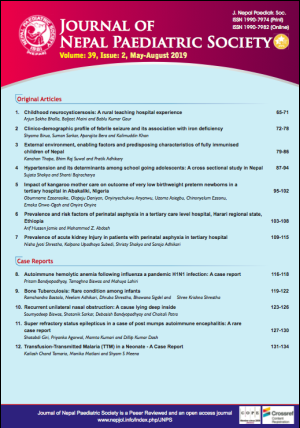Childhood Neurocysticersosis: A Rural Teaching Hospital Experience
DOI:
https://doi.org/10.3126/jnps.v39i2.27425Keywords:
ELISA, Neurocysticercosis, NeuroimagingAbstract
Introduction: Neurocysticercosis (NCC) is caused by the larval stage of Taenia Solium. Neurocysticercosis is the most common cause of acquired epilepsy in developing countries. In India NCC has been identified as a significant cause of seizures.
Methods: This prospective observational study was conducted on 150 children of NCC up to 18 years of age in a tertiary care hospital. The diagnosis was based on clinical and laboratory/ radiological evaluation of the patients. Socio-clinical, radiological and serological data of the patients were analysed.
Results: A total of 150 children were enrolled in this study. The commonest age group of the cases in this study was six to 10 years. Male to female ratio was 1.8:1. The largest percentage of cases belonged to upper lower class (56%) and lowest was 4% in upper class. Sixty percent subjects were non vegetarian. Seizures were the most common presentation (96%). Headache was present in 44% cases. Single lesion was commonest type of lesion on radiological examination with frontal cortex as most commonly involved area of brain. Stage II NCC was commonest type of lesion on MRI. EEG was abnormal in 38% cases. Serum ELISA for cysticercosis was positive in 10% cases. Number of lesions was not associated with age group, type of seizure or any particular area of brain.
Conclusion: Stage II NCC the commonest type of NCC. Single lesion NCC was more common than multiple lesions. All cases with atypical presentation and positive ELISA had multiple lesions. Frontal portion of cortex was most commonly involved.
Downloads
Downloads
Published
How to Cite
Issue
Section
License
Authors who publish with this journal agree to the following terms:
Authors retain copyright and grant the journal right of first publication with the work simultaneously licensed under a Creative Commons Attribution License that allows others to share the work with an acknowledgement of the work's authorship and initial publication in this journal.
Authors are able to enter into separate, additional contractual arrangements for the non-exclusive distribution of the journal's published version of the work (e.g., post it to an institutional repository or publish it in a book), with an acknowledgement of its initial publication in this journal.
Authors are permitted and encouraged to post their work online (e.g., in institutional repositories or on their website) prior to and during the submission process, as it can lead to productive exchanges, as well as earlier and greater citation of published work (See The Effect of Open Access).



